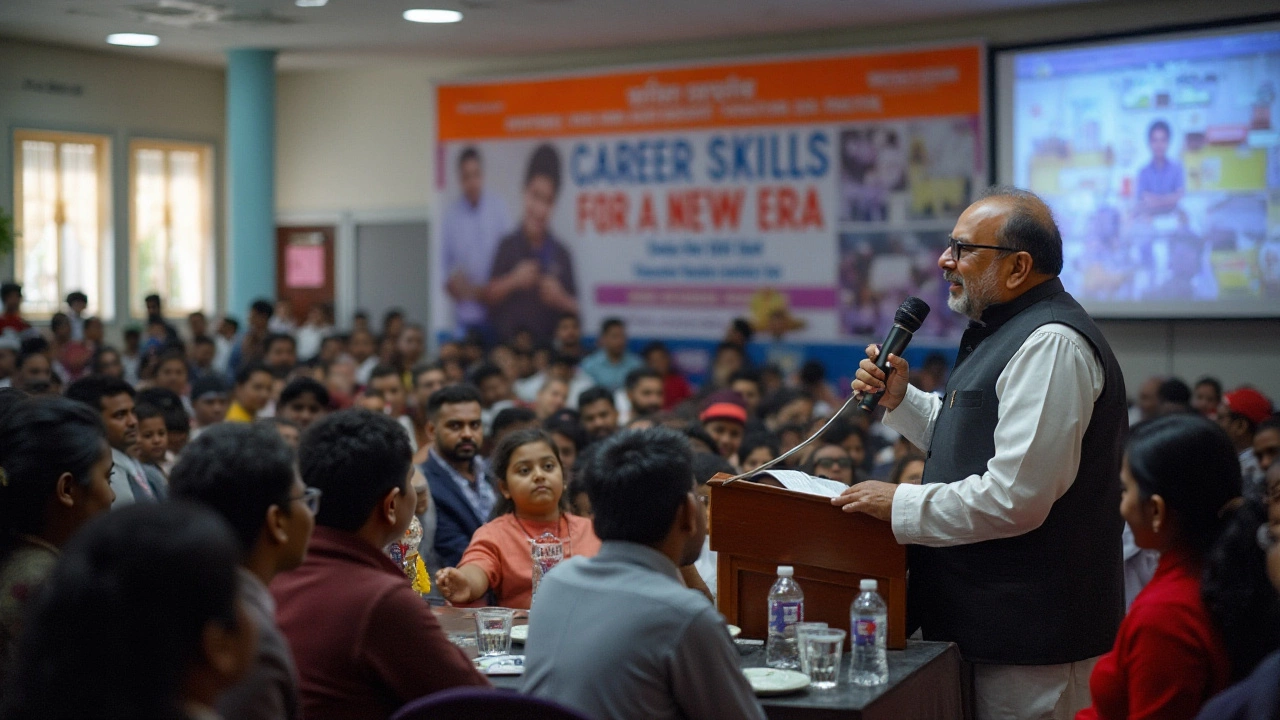In today's world, the pathway to a fulfilling career doesn't always follow the traditional route of a college diploma. With tuition fees skyrocketing and student debt reaching staggering heights, many are exploring alternatives that promise both financial and career security. Vocational training has emerged as a compelling option, offering hands-on experiences and specialized skills tailored for specific trades and industries.
The demand is growing rapidly for skilled labor across various sectors, from healthcare to technology. This demand often outpaces the supply of qualified workers, thus spotlighting the importance of vocational training. As we delve into this topic, we will explore how vocational training stands up against a college education, what benefits it holds, and how government initiatives are nurturing this form of learning.
- The Current Educational Landscape
- Understanding Vocational Training
- Why Choose Vocational Training?
- Government Support and Programs
- Success Stories from Vocational Paths
- Making the Right Educational Choice
The Current Educational Landscape
The landscape of education in the 21st century is undergoing a remarkable transformation. As technological advances reshape industries and the job market fluctuates, traditional educational models are being reevaluated. In the past, a four-year college degree was almost synonymous with success and stability. However, today people are questioning the cost-effectiveness of this path, especially when burdened by student loans that average around $30,000 per graduate in the U.S.
With a growing realization that a college education doesn't guarantee job security, many are turning to vocational training as a viable alternative. Vocational training programs are designed to equip students with the specific skills and practical experience needed for particular trades. This is crucial in an economy where sectors such as healthcare, IT, and skilled trades are experiencing a shortage of qualified professionals. A study by the Georgetown University Center on Education and the Workforce found that by 2027, nearly 30% of job openings will require some form of vocational training or an associate degree.
The government recognizes this dynamic shift and is increasing support for vocational programs. Initiatives like these are critical in bridging the gap between the workforce and educational qualifications. According to a recent report by the U.S. Department of Education, federal funding for career and technical education (CTE) programs has been at its highest, aligning educational outputs with industry demands more efficiently than ever before.
"Education must not simply teach work – it must teach life," said W. E. B. Du Bois, emphasizing the need for practical education that is both useful and meaningful. In today’s context, this resonates with the rising preference for skill-based careers over theoretical knowledge alone.
As diverse educational pathways become more accepted, students and parents are exploring options that align with personal and financial needs. The flexibility offered by vocational training programs, often shorter in duration and less costly than traditional degrees, appeals to many. These programs are often embedded with opportunities for apprenticeships and real-world engagements, ensuring students gain invaluable on-the-job experience even before they fully enter the workforce.
Understanding Vocational Training
Vocational training, sometimes referred to as career education or technical education, is a form of instruction focused on equipping students with practical skills needed for specific occupations. Unlike traditional academic routes, which often emphasize theoretical knowledge, vocational programs are designed to be hands-on. They immerse learners in real-world environments where they can experience direct application of their skills and knowledge. This type of education is typically less time-intensive than a conventional college degree, allowing individuals to enter the workforce more quickly and start earning sooner.
Vocational training covers a wide array of industries, from the mechanical arts to digital technology, and even health and care services. Programs can range from certification courses lasting a few months to more intensive associate degrees that might take up to two years. The beauty of these programs lies in their specificity; they are tightly aligned with industry needs and current job market trends. This ensures graduates are well-prepared for their roles. In fact, according to the Bureau of Labor Statistics, jobs in fields like healthcare support and information technology—where vocational training is prevalent—are projected to grow significantly by 2030.
According to Dr. Emily Ronan, a leading educator in industrial arts, "Vocational training is not simply an alternative to college; it’s a critical component of our economic structure, providing a skilled workforce that is essential for various industries."To put things in perspective, it's worth exploring some of the empirical benefits vocational training brings to the table. Students often pay a fraction of the cost of university programs and can often complete their studies debt-free. Moreover, hands-on learning provides immediate readiness, contrasting with the sometimes elongated adjustment period college graduates face when entering their professional lives.
Different Paths within Vocational Training
Vocational training is diverse, offering numerous paths that align with different interests and professional goals. Many community colleges and technical schools provide specialized programs in areas such as automotive mechanics, culinary arts, computer graphics, and practical nursing. Each vocation demands a unique set of skills, and students are trained not just in execution, but also in thinking critically about their work. This shapes them into versatile employees who can adapt to new challenges.
It is also fascinating to observe that many vocational careers boast impressive salary potentials despite the relatively short training periods. For instance, commercial pilots, who are often trained through vocational pathways, average salaries well into six figures annually, while computer support specialists, another popular vocational field, can earn upwards of $63,000 per year. These statistics illustrate the financial feasibility and rewarding nature of choosing vocational training. Adding to the allure, many vocational students often graduate without the heavy burden of debt that their college-going counterparts might face.
Considering all these factors, it becomes clear why vocational training continues to grow in popularity. It offers a pragmatic approach to education—one that promises rapid entry into the job market, aligned with current industry demands and with a swift pathway to earning. Vocatational training, supported by various government initiatives and subsidies, demonstrates that real-life experience and targeted learning can be just as valuable as a traditional college education, if not more so for certain individuals.

Why Choose Vocational Training?
Choosing vocational training over the traditional college route is an increasingly viable option for many learners seeking a direct and practical career path. One of the greatest advantages of vocational training is its focused approach. Unlike the broad curriculum offered by conventional colleges, vocational programs are designed to provide specialized skills and knowledge. This direct-to-career connection means that many students can step directly into the workforce after completing their training, often bypassing the months, or even years, it might take a college graduate to find an appropriate job.
Another compelling reason is the financial aspect. The cost of vocational training is typically a fraction of what students might expect to pay for a four-year college education. For those wary of the burden of student loans, vocational training offers a far more affordable alternative. This is especially pertinent given the rising concerns of student debt, which as of recent years, has climbed to staggering figures in many countries. By opting for vocational education, students can often avoid this financial pitfall entirely, gaining valuable skills without the associated financial strain.
Moreover, the hospitality, healthcare, and technology industries continually seek skilled workers, and they often find a reliable pool of talent through vocational schools. Careers like welding, plumbing, and even computer networking are always in demand, yet they do not necessarily require a college degree. A vocational training program can prepare students for these specific job markets more efficiently. As reported by studies, careers in these skilled trades can be both financially lucrative and personally rewarding.
"According to a recent survey, over 80% of vocational school graduates find employment in their chosen field within six months," notes research from a leading educational statistics organization.
Beyond the individual benefits, there's a growing recognition of the broader economic impact vocational training can have. Skilled workers are essential to the fabric of any economy, and programs that equip students with these skills ensure that industries can continue to function and innovate. Many vocational programs work closely with local businesses to align their curriculums with actual market needs, ensuring graduates possess relevant and up-to-date skills. This collaboration not only enhances the employability of graduates but also supports local economies by ensuring a steady stream of qualified candidates for essential roles.
For those with a clearer vision of their career desires, vocational training also offers a higher degree of satisfaction. Instead of spending years studying subjects that may not directly impact their chosen field, students can dive deeply into their passions from the outset. This targeted learning approach often leads to a more engaging and enriching educational experience. By focusing solely on their area of interest, students can develop a deeper understanding and proficiency, making them valuable assets to potential employers. Indeed, many find that this specialized focus allows them to advance their careers more quickly than their college-educated peers.
It's important, however, for prospective students to weigh their personal goals and career aspirations carefully when considering vocational training. While it offers a range of benefits, it's not the perfect fit for everyone. Certain professions still require a college degree, and some students may still find value in the broader educational experience that college provides. That said, for those looking to jumpstart their careers with practical, marketable skills, vocational training stands out as an appealing and strategic choice worth considering.
Government Support and Programs
The landscape of vocational training is significantly shaped by government programs and initiatives aimed at bridging the skills gap in critical industries. Recognizing the importance of skilled labor in maintaining a competitive economy, many governments across the globe have enacted policies and launched programs to promote vocational education. For instance, in countries like Germany, the dual education system integrates vocational training with educational learning, ensuring students graduate with relevant occupational skills. This model has been lauded worldwide and is often cited in discussions about enhancing the efficacy of vocational education.
The United States, too, has made strides with legislation such as the Carl D. Perkins Career and Technical Education Act. This act provides essential funding to improve career and technical education (CTE) programs, helping millions of students gain critical career skills that align with industry needs. The act aims to modernize CTE programs to ensure they are aligned with local labor market needs, fostering partnerships between secondary and postsecondary institutions and employers.
"Vocational training supported by the government can be a powerful tool for tackling unemployment," said Eric Hanushek, a renowned economist who focuses on education policy. "By aligning training programs with the evolving job market, we not only equip individuals with necessary skills but also stimulate economic growth."
The European Union has also been a proponent of vocational training through initiatives like the European Alliance for Apprenticeships, which seeks to strengthen the quality and supply of apprenticeships across member states. The alliance advocates for increased support and policy coherence across member governments, facilitating an environment where vocational training is not only accessible but widely recognized as a viable educational pathway.
Impact on Local Communities
In addition to these broader initiatives, local governments often play a crucial role in directly supporting vocational training sectors. City and regional governments frequently work in partnership with businesses and educational institutions to provide tailored training solutions that meet local economic needs. These collaborations can result in more vibrant local economies where career education directly addresses the demand for skilled labor in specific industries that are prevalent within a region.Statistics Reflecting Success
| Program Name | Region | Success Rate |
|---|---|---|
| Apprenticeship 2000 | North Carolina, USA | 95% job placement |
| Kosken Hopea | Finland | 90% in-field employment |

Success Stories from Vocational Paths
When you think of successful career paths, the narrative of going to college, obtaining a degree, and landing a cushy office job often comes to mind. However, vocational training tells a different story—one that's equally rewarding and often quicker to reach its climax. Millions of people have found lucrative careers through vocational training, bypassing the need for a traditional college degree. Take the case of Sarah Thompson, who chose culinary arts vocational training over a four-year degree program. Today, she is the owner of a trendy downtown diner that employs over a dozen people and serves hundreds of satisfied customers daily.
Sarah's story is not unique. Across industries, many individuals have found a direct route to success through vocational education. Electricians, plumbers, and even healthcare technicians make up some of the fastest-growing sectors, according to the Bureau of Labor Statistics. The need for specialized skills is at an all-time high, often allowing people who complete vocational training quicker entry into the workforce, a perk that can’t be underestimated. For example, an HVAC technician usually completes their training in 2 years or less, entering directly into a field that promises job stability and a solid income.
One of the lesser-known advantages is the low student debt associated with vocational training. While college students struggle under the weight of student loans that can take decades to pay off, vocational students often pay far less and start earning enough money to support their newfound independence quickly. Mark Higgins, a graduate of a vocational welding program, put it succinctly: "The tools of the trade were my lessons, and my paycheck became my diploma." His story is a prime example of how skipping the degree can lead to fulfilling careers, complete with financial freedom and growth opportunities.
"Choosing vocation over education debt was the best decision I ever made," says Mark Higgins, a welder whose earnings outpaced his college-bound peers within years of completing his vocational training.
Vocational training also attracts innovators who bring fresh perspectives to traditional roles. Roberta Martin, a software developer focused on cybersecurity, opted for a coding boot camp instead of a computer science degree. She cracked into the tech industry through hands-on experience, bypassing years of lectures, and now works for a startup rated as one of the best to watch by industry pundits. Her journey underlines the disruptive power of this approach in modern workplaces.
Government programs supporting vocational training have helped many companies see the value of hiring from these alternative educational avenues. Many companies now partner directly with vocational programs to create tailored apprenticeship opportunities. These partnerships ensure that graduates not only have the technical skills needed but also an understanding of the company's culture and expectations, leading to higher job retention rates. Employers often find that such employees need less training and are more job-ready from day one, offering obvious advantages.
Making the Right Educational Choice
Deciding on the right educational path is not just a choice; it's an investment in one's future. For many, the allure of a college degree is hard to resist, yet for others, vocational training provides a pragmatic and enriching alternative. With the world of work evolving at a breakneck pace, the choice between traditional college and vocational training becomes both pivotal and personal.
The decision-making process relies heavily on individual interests, financial considerations, and career ambitions. A four-year college degree often offers a broad spectrum of knowledge but at the cost of considerable financial investment and time. On the other hand, vocational training focuses on imparting practical skills aimed directly at the job market. In the US, the average student graduates with over $28,000 in debt, while vocational training, by contrast, presents a pathway to employment with significantly reduced expenses.
A significant 2018 report by the Georgetown University Center on Education and the Workforce revealed that many jobs requiring sub-bachelor's credentials are projected to see growth much faster than those needing a college degree. If job stability and rapid entry into the workforce are priorities, vocational training is often the wiser choice.
The flexibility of vocational training allows students to engage with and adapt to industries where skilled labor is in high demand. Fields such as healthcare, technology, and skilled trades benefit from this focused and practical form of education. Job security is an attractive aspect of such paths, given the impending shortage of skilled workers as predicted by various economic studies.
The value of vocational training is unparalleled," said Mary Alice McCarthy, director of the Center on Education and Skills at the New America Foundation. "It provides both a sturdy foundation for immediate employment and a responsive approach to the demands of our changing economy."
Before making a choice, it's pivotal for students and their families to weigh their own goals against the economic landscape they're entering. Many programs today offer flexible learning options, which include apprenticeships or internships that not only enhance learning but also network building. Such programs often boast high employment rates post-completion, a testament to their effectiveness and relevance.
Lastly, consider discussing potential paths with career counselors and industry professionals. Often, they provide insights that aren't readily apparent to students just embarking on their journey. Choosing between college and vocational training doesn't have to be a gamble; it can be a strategic, informed choice that aligns seamlessly with personal goals and the practicalities of the job market. Whichever path one decides, the key is to remain adaptable and be ready to learn new skills as industries continue to evolve.





Write a comment